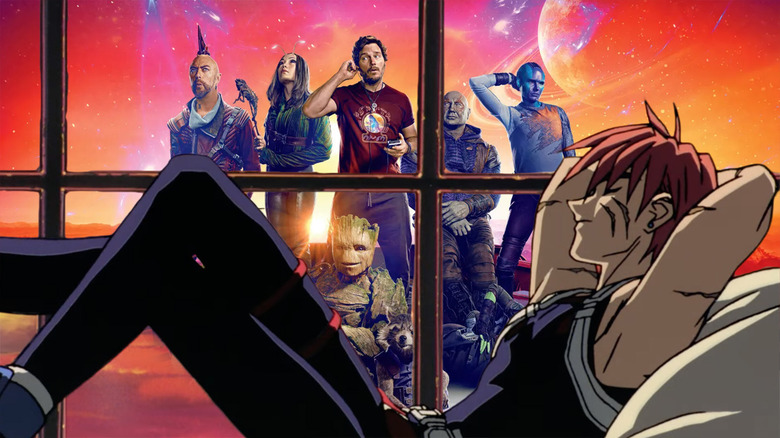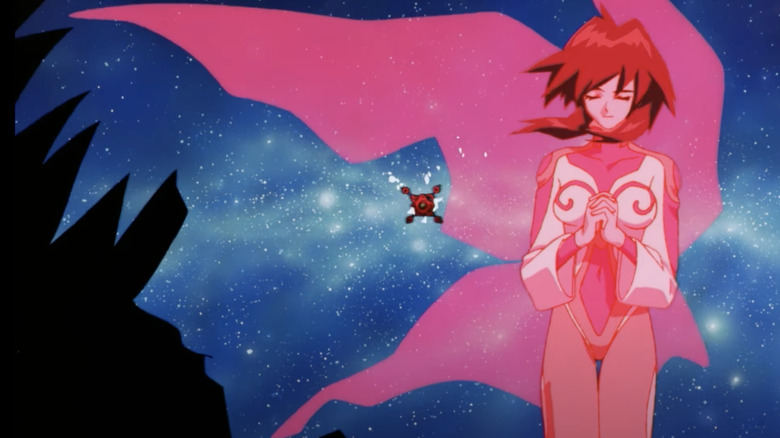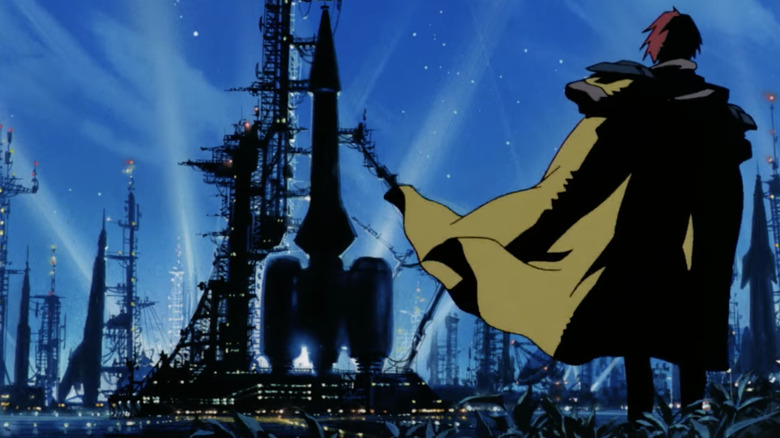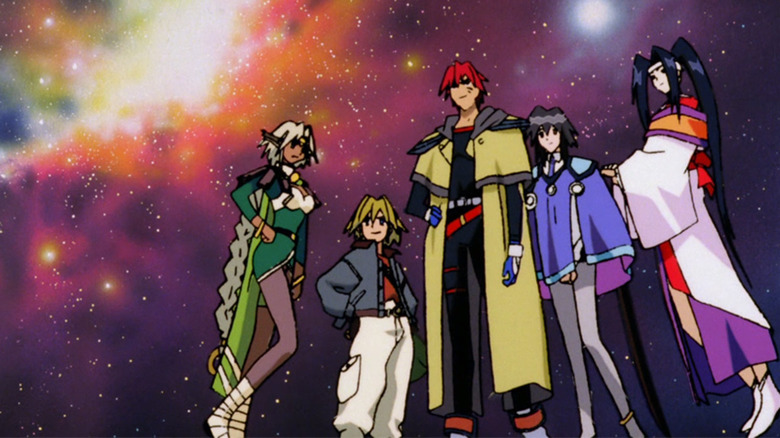If You Like Guardians Of The Galaxy, Outlaw Star Is The Anime For You
"Guardians of the Galaxy Vol. 3" is a bittersweet movie. It will be the last time we'll see all these characters united, but not to fret. If you're in the mood for a story about misfits flying around from adventure to adventure in a starship, you're blessed with possibilities.
"Firefly," the cult classic space western by "The Avengers" director Joss Whedon, is an obvious one — its influence hangs over the "Guardians" films. "Firefly," though, owed its own debts to past science fiction. There's a persistent rumor that the image of the naked River Tam (Summer Glau) in a box was taken from a nearly identical shot in a 1998 anime. The anime in question? "Outlaw Star."
Set in the far future when mankind has colonized the stars, our lead is Gene Starwind, who dreams of traveling space yet has been grounded since his father died in a pirate attack years prior. Gene runs a repair business with his best friend, pre-teen mechanic Jim Hawking, but his moment in the sun comes when they're hired by the outlaw "Hot Ice" Hilda.
It's not long before Gene and Jim get their hands on an experimental ship, which they dub the Outlaw Star. Included in the package is Melfina, a bio-android designed to interface with the ship. The bad news? They've got pirates on their tail, who think Melfina can lead them to a treasure called "The Galactic Leyline." Along the way, Gene and co. pick up two extra crewmates: alien werecat Aisha Clan-Clan and samurai assassin "Twilight" Suzuka (nicknamed because she only kills her targets at sunset).
The series is a mish-mash of genres, tones, and characters all within a space opera framework. If you liked the "Guardians of the Galaxy" trilogy for its cranky characters and eagerness to get weird, you'll love "Outlaw Star."
Background on Outlaw Star
Like its characters (and those in "Guardians of the Galaxy" for that matter), "Outlaw Star" is an underdog. It began as a manga written by Takehiko Itō and published in Shuiesha. Unfortunately, the series' blast-off didn't pass orbit. The series ran for only three volumes and 21 chapters, with no ending, and was never even officially released in English. However, Itō had a partner — "Hajime Yatate," the shared pseudonym of the staff at the animation studio Sunrise.
With the manga out of commission, it fell to the 26-episode anime to complete the story and make an impression along the way. However, "Outlaw Star" was soon overshadowed by Sunrise's other space western anime, released just a few months later: a little show you might've heard of called "Cowboy Bebop."
Unlike its manga source material, the "Outlaw Star" anime made it stateside and aired on Cartoon Network's Toonami block in 2001. Despite some heavy censorship — episode 23, the lewd "Hot Springs Planet Tenrei," was excluded from broadcast entirely — the series built a following as part of the aughts' nascent U.S. anime boom. After Adult Swim relaunched Toonami in the 2010s, "Outlaw Star" was added back to the programming line-up in 2017.
It's not an understatement to say that U.S. import rescued "Outlaw Star." What made it a hit?
Sci-fi fantasy pulp
There's no mood-setter on television like a good theme song. Masahiko Arimachi's "Through The Night" — upbeat like a pop song but headbanging like great rock 'n roll — promises a thrilling romp as it plays over still shots of the main cast intercut with kinetic action. "Through The Night" won't make you stop and think, but the relentless pacing keeps you thrilled. "Outlaw Star" keeps the promise its theme makes.
The story is best described as "Treasure Island" in the world of "Star Wars," but the show's influences weren't only Western. On every planet that the cast visits, city skylines are lit up by neon signs written in Chinese. The Outlaw Star itself, and rival pirate ships, also have tactile "grappler arms" as weapons, creating a mecha anime vibe. (Sunrise is the home studio of the "Gundam" franchise). The pirates also wield Tao magic and use yin-yang symbols as their logo. "Outlaw Star" mixed sci-fi and fantasy in much the same way the Marvel Cinematic Universe does — Gene's main weapon is a Caster Gun, which fired special, spell-casting shells. However, the setting was only half of what made "Outlaw Star" fun, because, at the end of the day, it was a playground for the characters.
The leads are constantly broke and indebted to businessman Fred Luo, who keeps them afloat less because of ROI and more because of his crush on Gene. Many episodes were just the Outlaw Star crew taking odd jobs to make ends meet. These ran the gamut from pulpy fun (episode 16 is about them recovering lost treasure from an ocean planet) to downright bizarre (a psychic cactus is the villain of episode 13). The search for the Galatic Leyline eventually took precedence, but "Outlaw Star" would, and often did, work perfectly fine as a hang-out show about a starship crew.
An unlikely crew
The fun in "Guardians of the Galaxy" was that these characters didn't belong together. "All you do is yell at each other," says Nebula in "Vol. 2" — she's right and how couldn't she be? Peter Quill is full of himself, Rocket is a troll, Gamora is the sole light of maturity, and Drax is a dim bruiser. These characters functioned together in spite of their personalities, not because of them.
The characters in "Outlaw Star" are just as unlikely a team. Gene is a typical lecherous, leap-before-you-look action hero while the precocious Jim takes pride in being smarter than his older partner. Aisha (the Drax of the show) is loud, rambunctious, and prides herself as a great warrior but always falls flat on her face. Suzuka — like Gamora, the deadliest woman in the galaxy — keeps herself above the fray and only sticks around because of how "interesting" (weird) the others are. Melfina is another straight woman, but because of naïveté rather than maturity like Suzuka. Between her desire to know her origins and her burgeoning feelings for Gene, she's the heart of the show.
While "Outlaw Star" concluded its story after just 26 episodes, it ended with the unfulfilled promise of another adventure with these characters. Frankly, I wish the series hadn't run to the finish line so quickly — it's the type of show that could've sustained itself with dozens of standalone episodes. "Filler" is a dirty word in anime, but "Outlaw Star" proved how diversions can be more fun than the eventual destination.
"Outlaw Star" is available to stream on Hulu and Funimation, and without the censorship that plagued the original U.S. release.



